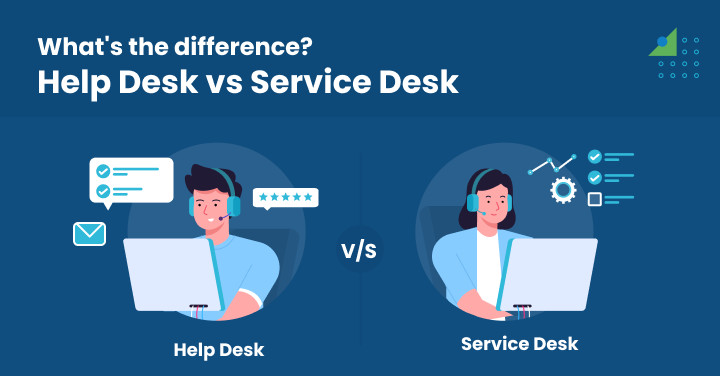Introduction
Modern organizations rely heavily on the IT service desk as the backbone of business operations. Acting as a unified point of contact, it handles service requests, manages IT assets, and oversees a wide range of IT service management tasks—from incident management to asset tracking.
The IT service desk not only empowers IT service delivery teams but also ensures faster resolution of technical problems in a personalized and efficient way.
With AI-driven tools and proactive workflows, the service desk has become a core catalyst for business continuity and cyber resilience. Leveraging service desk software and service desk solutions, businesses are better equipped to handle threats, enforce policies, and educate users, making resilience a strategic priority.
The Service Desk as the First Line of Defense and a Human Firewall
The IT service desk serves as the frontline guardian of an organization’s digital ecosystem, acting as both a proactive shield and a responsive control center. In today’s evolving threat landscape, cyberattacks are no longer rare events but daily challenges.
By continuously monitoring IT services, swiftly responding to incidents, and managing escalations, the service desk operates as a “human firewall” that safeguards critical business assets.
It plays a dual role—detecting anomalies that automated systems might overlook and ensuring compliance with security standards that keep operations aligned with organizational policies.
Well-trained IT service desk teams are uniquely positioned to recognize unusual user behavior, such as abnormal login attempts, unauthorized data access, or suspicious application usage. Their ability to escalate potential risks to security experts before they escalate into breaches makes them indispensable to cyber resilience.
Many organizations still mistakenly equate the service desk with a simple help desk. While a help desk offers reactive technical support, the IT service desk goes beyond—delivering proactive incident management, embedding security awareness, and ensuring a seamless user experience.
With the support of advanced service desk software and integrated service desk solutions, businesses can transform their service desk into a critical line of cyber defense, capable of addressing complex IT challenges effectively and sustainably.
Early Threat Detection and Identification
The IT service desk plays a pivotal role in early threat detection. Its advanced service desk software integrates with monitoring tools to track user requests, flag anomalies, and investigate suspicious activity. By managing inquiries through structured workflows, it helps security teams identify risks early and escalate them promptly.
Acting as the communication bridge between IT teams and end-users, the IT service desk ensures anomalies are detected before they cause disruptions. Leveraging AI-enabled service desk solutions for proactive monitoring, organizations gain resilience and operational continuity in the face of evolving threats.
Security Policy Enforcement and Adherence
A core responsibility of the IT service desk is enforcing security policies and ensuring adherence to organizational protocols. Using service desk software, teams enforce password compliance, access controls, and identity management, all while maintaining service level agreements. By integrating with ITSM best practices, the service desk aligns IT operations with business goals while reducing vulnerabilities.
Through automated workflows in service desk solutions, organizations can standardize processes, track compliance, and maintain high levels of vigilance against cyber risks. This consistent enforcement ensures resilience against an ever-changing threat landscape.
User Education and Security Awareness
Cyber resilience is incomplete without user education. The IT service desk trains employees on recognizing phishing attempts, following safe password practices, and reporting suspicious activity.
By embedding education into service desk software, organizations empower end-users with accessible knowledge bases, self-service security guides, and proactive alerts.
Moreover, continuous training for service desk agents ensures that they remain well-versed in emerging threats. With the right service desk solution, companies can transform every employee into a vigilant participant in security defense.
The Service Desk’s Role in Incident Response and Containment
When incidents occur, the IT service desk is the single point of contact to ensure resolution. Using advanced service desk software, teams log incidents, categorize them, and prioritize responses. This structured process enables effective containment and rapid resolution while minimizing downtime.
By leveraging AI-driven service desk solutions, repetitive containment tasks are automated, affected systems are isolated quickly, and stakeholders are notified instantly. This rapid response strengthens resilience while reducing operational risks.
Initial Incident Triage and Logging
The triage process starts with accurate incident logging. Through service desk software, every detail is captured—from the type of incident to the affected assets. This ensures that incidents are prioritized appropriately and visible to all stakeholders.
Rapid Response and Containment
Once logged, the IT service desk coordinates immediate actions to reduce the impact. With the help of service desk solutions, automation accelerates containment, enabling faster resolution while enhancing the overall resilience of the IT environment.
Recovery and Post-Incident Learning
The IT service desk plays a central role in recovery after an incident. Teams coordinate with technical experts to restore IT systems, recover lost data, and resume business operations quickly. Features within service desk software—such as automated asset tracking, workflow management, and secure backups—facilitate recovery at scale.
Beyond immediate restoration, the service desk contributes to long-term resilience through post-incident analysis. By documenting incidents within a knowledge base, updating security policies, and refining processes via service desk solutions, organizations continuously improve their defenses.
Enabling Proactive Resilience through Strategic Integration
Resilience goes beyond response—it is proactive. The IT service desk integrates predictive analytics, AI-powered monitoring, and automation into its workflows. With advanced service desk software, potential risks can be predicted and mitigated before they escalate.
Strategic collaboration across IT and business operations, supported by scalable service desk solutions, ensures seamless communication and stronger resilience across all functions.
Leveraging Service Desk Technologies for Security
Modern service desk software and service desk solutions provide organizations with advanced capabilities:
| Service Desk Technology | Security Benefit |
|---|---|
| AI-powered Ticketing | Automates incident detection and prioritization |
| Predictive Analytics | Anticipates threats before escalation |
| Automation Tools | Executes containment and recovery protocols efficiently |
| Knowledge Base | Empowers users with self-service guides |
| Cloud Integration | Provides secure, scalable support across locations |
With these technologies, the IT service desk ensures 24/7 monitoring, intelligent routing, and real-time reporting, all of which are crucial for cyber resilience.
Collaboration and Communication
No service desk operates in isolation. Effective collaboration between the IT service desk, IT operations, and security teams is critical for swift incident management. By sharing insights, coordinating strategies, and aligning priorities, the service desk ensures a unified approach to resilience.
Through seamless communication tools embedded in service desk software and integrated service desk solutions, organizations eliminate silos, increase transparency, and enhance overall operational effectiveness.
Conclusion
The IT service desk is more than just a support function—it is the cornerstone of a cyber-resilient organization. From threat detection to policy enforcement, from incident containment to recovery, and from user education to proactive monitoring, the service desk plays a vital role in defense.
By investing in advanced service desk software and adopting comprehensive service desk solutions, organizations can protect assets, ensure continuity, and build a culture of resilience.
FAqs:
It refers to the ability of the IT service desk to maintain uninterrupted IT support and incident management, even during cyberattacks, using advanced service desk software and service desk solutions.
By monitoring suspicious activities, flagging anomalies, and implementing preventive measures through service desk software.
Continuous training in security awareness, incident response, and process optimization using service desk solutions.
It coordinates restoration of systems and data using service desk software features like asset tracking and backup.
Yes. Automated workflows in service desk solutions streamline detection, response, and reporting.
Collaboration enabled by service desk software ensures IT and security teams remain aligned for stronger defenses.
It requires scalable, cloud-enabled service desk solutions that provide secure, centralized support across diverse locations.






